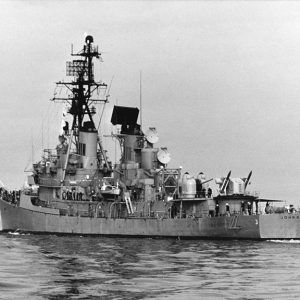calsfoundation@cals.org
USS John King (DDG-3)
The USS John King was a Charles F. Adams–class guided-missile destroyer launched in 1960 and named after John King, a U.S. sailor who was one of only nineteen men awarded two Medals of Honor for heroism.
John King was born in Ireland on February 7, 1862, and joined the U.S. Navy in 1893. He received a Medal of Honor for a May 29, 1901, incident in which he averted disaster with his swift response to a boiler explosion aboard the USS Vicksburg. Eight years later, he received a second Medal of Honor for his actions in another boiler explosion on the USS Salem, in which he saved twelve seamen despite suffering severely scalded arms. King returned to Ireland after his twenty-six-year naval career ended but returned to the United States after the death of his wife. He died in Hot Springs (Garland County) on May 20, 1938, and is buried in Hollywood Cemetery there.
The Bath Iron Works in Bath, Maine, received a contract to construct the USS John King on March 28, 1957, and began construction on August 25, 1958. The vessel, originally designated DD-953 but changed to DDG-3 in June 1957, was christened by Cecile Newton Kilday, the wife of Texas congressman Paul J. Kilday; launched on January 30, 1960; and commissioned on February 4, 1961, at Boston, Massachusetts, under the command of Commander A. M. Sackett. The 4,526-ton guided-missile destroyer was 437 feet long and forty-seven feet wide, with a twenty-foot draft. The King’s two geared turbine engines turned two propellers that could move the ship at speeds of more than thirty knots. The vessel was armed with two five-inch guns and Tartar and ASROC missiles, and it carried a crew of 333 to 350 sailors. The ship’s superstructure was constructed solely from aluminum, and its electronic equipment and arms were of the most modern design at the time.
The USS John King had its initial training and testing out of Guantanamo Bay, Cuba, before reporting for duty at Norfolk, Virginia, on September 7, 1961. In November, the King sailed for Europe, joining the Sixth Fleet in the Mediterranean Sea in January 1962. The ship returned to Norfolk in April before conducting missile exercises and training in the Caribbean Sea; the King then spent four days in Washington DC in July to entertain the Secretary of the Navy and a group of congressmen.
The USS John King was undergoing repairs at Norfolk in October 1962 when the Cuban Missile Crisis erupted; the ship joined the blockade of the island on November 6 and then operated in the Caribbean with the aircraft carrier USS Enterprise before returning to Norfolk on December 8.
The King would continue to operate in the Caribbean and Mediterranean, as well as around the coastal United States, before being decommissioned on March 30, 1990. The ship was stricken from the navy list on January 12, 1993, and placed in the Naval Inactive Ship Maintenance Facility in Philadelphia, Pennsylvania. On February 10, 1999, the USS John King was sold for $132,951 to International Shipbreaking, Ltd., in Brownsville, Texas, which scrapped the vessel.
For additional information:
“John King.” Naval History and Heritage Command. https://www.history.navy.mil/research/histories/ship-histories/danfs/j/john-king.html (accessed October 2, 2020).
“USS John King (DDG-3).” Unofficial U.S. Navy Site. https://www.navysite.de/dd/ddg3.htm (accessed October 2, 2020).
“USS John King (DD-953/DDG-3).” NavSource.org. http://www.navsource.org/archives/05/01003.htm (accessed October 2, 2020).
Mark K. Christ
Central Arkansas Library System
 Military
Military World War II through the Faubus Era, 1941 through 1967
World War II through the Faubus Era, 1941 through 1967 John King
John King  USS John King (DDG-3)
USS John King (DDG-3) 



Comments
No comments on this entry yet.